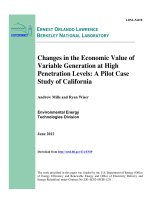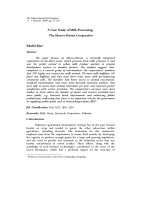ktn eep case study ion science
Bạn đang xem bản rút gọn của tài liệu. Xem và tải ngay bản đầy đủ của tài liệu tại đây (225.08 KB, 2 trang )
Ion Science
Turning to the Integrated Products
Manufacturing KTN to help investigate the
possibility of a portable benzene-specific
measurement device, Ion Science
accessed the knowledge and networks it
needed to apply for EU funding.
Following a major European collaborative
project, the company has the
breakthrough technologies and
methodologies it needs to create the novel
hand-held device. Widely used as a
precursor in the production of many
products from drugs to petrol, benzene is
highly regulated yet testing remains highly
expensive and time consuming. Crucially,
the significant delay between sample
collection and lab results offers no
protection from exposure.
Air pollution breakthrough
for Ion Science
Case Study
With EU legislation and industrial safety requiring stringent control of the poisonous and
carcinogenic chemical benzene, photoionisation detection specialist Ion Science saw an opportunity
to leverage its know-how to provide a solution.
www.integratedproductsktn.org.uk
Ion Science was convinced that a portable,
real-time device would not only prevent
people from unknowingly receiving
dangerous doses but also overcome the
existing problem of sample degradation. The
problems the project itself had to overcome
centred on miniaturisation. The 15 metre
gas chromatography column through which
air samples are usually pumped during
laboratory testing had to be reduced, for
example, to just 54 millimetres.
To help the company design, develop and
package this entirely new device the
Integrated Products Manufacturing KTN
first conducted a feasibility study. This
resulted in detailed plans for a device
combining an innovative proportional
integrated detector (PID) and a novel pre-
concentrator and gas chromatography
column – as well as a GPS and
telecommunications module enabling
remote monitoring. The KTN then identified
European organisations with the specialist
skills needed and built a consortium –
which bid successfully for EU funding.
‘We were heavily involved in the project’s
management and in supporting all the
partners across Europe,’ explains Pete
Fowell, who carried out the work. ‘As we
have such a great number and variety of
experts to call on we were also able to
develop key innovations including the
gas column and the filtering and manifold
systems and carry out the required
rapid prototyping.’
The prototype to emerge from BEN-DET,
the three-year €1.57 million European
project, puts the partners in a very strong
position to develop a well-designed, well-
priced product. As industry and regulators
have been calling for such a device for
decades, it is expected that it could
generate sales of nearly €90 million over
five years. ‘The BEN-DET device has
emerged as an elegant and powerful
technology,’ says Ion Science’s Chief
Executive Officer Mark Stockdale. ‘It is
extremely well suited to benzene detection
but other prospective analytes might be
amenable to selective detection in future
variants. We are very pleased with the
performance in pre-trials of prototypes
and look forward to seeing it
through productionisation.’
For further information about Ion Science
please visit www.ionscience.com
“The BEN-DET device has
emerged as an elegant and
powerful technology. It is
extremely well suited to
benzene detection but
other prospective analytes
might be amenable to
selective detection in
future variants. We are
very pleased with the
performance in pre-trials
of prototypes and look
forward to seeing it
through productionisation.”
Mark Stockdale
Chief Executive,
Ion Science
www.integratedproductsktn.org.uk









